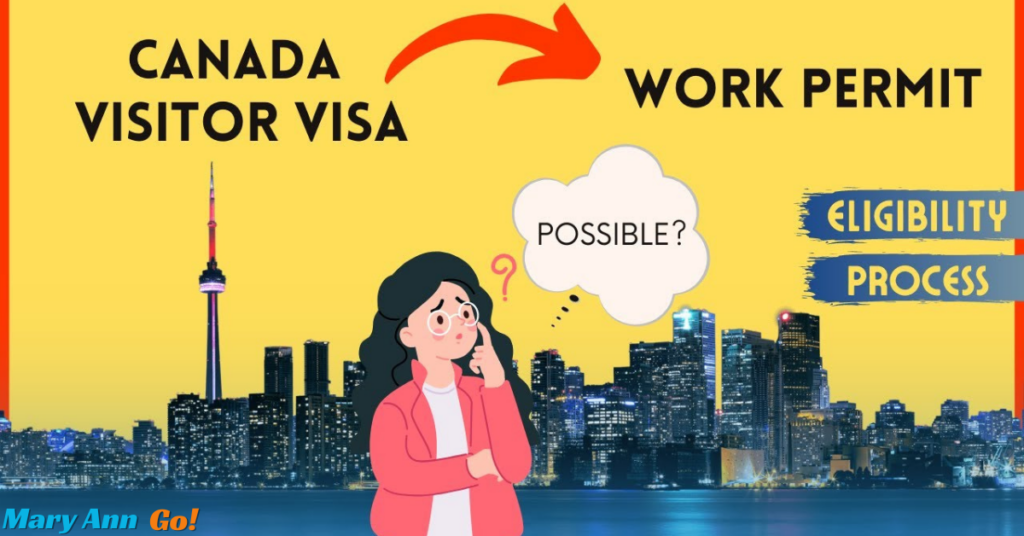Canada is a desirable destination for both tourists and those seeking exciting job opportunities. If you’re visiting Canada and the idea of working here has crossed your mind, you’re likely wondering if it’s possible to change your status from a visitor to a work permit holder. While the process can be complex, it is achievable under specific circumstances. This blog post will dive into the rules, the limited exceptions, and how to navigate the process if you’re considering this path.
The General Rule: Visitors Can’t Work in Canada

It’s important to understand the limitations of a Canadian visitor visa upfront. A visitor visa (or temporary resident visa) allows you to visit Canada for purposes like tourism, seeing family, or certain short-term business activities. However, it explicitly does not grant you the right to work for a Canadian employer. Working in Canada without proper authorization is a serious violation of immigration laws and could result in consequences like deportation or inadmissibility.
Limited Exceptions: When You Might Be Eligible
Despite the strict general rule, there are narrow situations where you might be able to apply for a work permit from within Canada while on a visitor visa:
- Job Offer with an LMIA: A Labor Market Impact Assessment (LMIA) is a document where a Canadian employer proves their need to hire a foreign worker due to being unable to find suitable Canadian citizens or permanent residents. If you’ve secured a job offer with LMIA support, you may be able to apply for a corresponding work permit from inside Canada.
- Post-Graduation Work Permit (PGWP): International students who graduate from a designated Canadian post-secondary institution may be eligible for the PGWP. This open work permit allows you to gain valuable work experience in Canada, and you could qualify even on a visitor visa.
- Accompanying Spouse/Common-Law Partner: If your spouse or common-law partner holds a skilled work permit in Canada, you could be eligible for an open work permit allowing you to work for any Canadian employer.
- Temporary Public Policies: Occasionally, Immigration, Refugees, and Citizenship Canada (IRCC) introduces limited-time pilot programs designed to address specific labor needs. A recent example allowed certain visitor visa holders already working in Canada to transition to work permits. It’s essential to stay updated on the IRCC website for the latest programs and eligibility.
How to Apply for a Visitor Visa to Work Permit Canada
If you think you meet one of the exceptions, the application process generally looks like this:
- Confirm Eligibility: Thoroughly assess the requirements of the specific work permit you qualify for. Ensure you have the necessary documentation and a solid understanding of the process.
- Gather Required Documents: This may include your passport, educational credentials, proof of relationship (if applicable), the LMIA-supported job offer, and other supporting documents.
- Apply Online: The majority of work permit applications are submitted through IRCC’s online portal. Complete the appropriate forms, pay applicable fees, and provide the required information.
- Biometrics: You may need to submit fingerprints and a photograph as part of your application.
- Processing: The time it takes IRCC to process your request can vary widely depending on the type of work permit and current caseloads.
Important Considerations
- Time Sensitivity: If you’re applying from within Canada, there are likely strict deadlines for submission once you become eligible (like graduating or getting an LMIA job offer). Plan to avoid missing these critical windows.
- The Burden of Proof is High: You’ll need compelling evidence to demonstrate you fit within one of the exceptions. IRCC officers assess these cases cautiously.
- No Guarantees: Even if you meet one of the narrow pathways, a successful outcome is not automatic.
The Ideal Approach: Getting Your Work Permit Beforehand
If your primary goal is to work in Canada, the most straightforward and secure path is to apply for and obtain the appropriate work permit before you arrive on a visitor visa. Here’s why this is preferable:
- Eliminates Uncertainty: With a work permit in hand, you have certainty about your ability to work legally in Canada. You won’t be tied to the narrow exceptions or stressful timelines of trying to transition your status after arriving.
- More Job Opportunities: Many employers would prefer to hire someone already authorized to work. Having your permit in order expands the job market you have access to.
- Peace of Mind: Starting this new chapter of your life knowing things are in place significantly reduces stress and lets you focus on finding the right opportunity and settling in.
Additional Things to Keep in Mind
Visitor Visa Restrictions: Even with a job offer, be aware that while on a visitor visa, there are constraints on activities related to job hunting. Familiarize yourself with what’s allowed to avoid complications.
Professional Help: The world of Canadian work permits and immigration processes can be complex. If you are unsure about your eligibility, and application procedures, or feel overwhelmed, seeking guidance from a regulated immigration consultant or lawyer can be invaluable.
Alternative Pathways: Canada has a diverse range of immigration programs beyond just work permits. If your longer-term goal is Canadian permanent residence, explore whether you fit the criteria for programs like Express Entry.
Conclusion
Navigating the transition from a visitor visa to a work permit in Canada requires careful planning and an understanding of the limited pathways available. If working in Canada is your dream, it’s best to explore securing the proper work permit before arrival. For further guidance and personalized immigration solutions, visit New Beginnings Immigration. Mary Ann Go and her team are here to assist you in making your Canadian work aspirations a reality.
